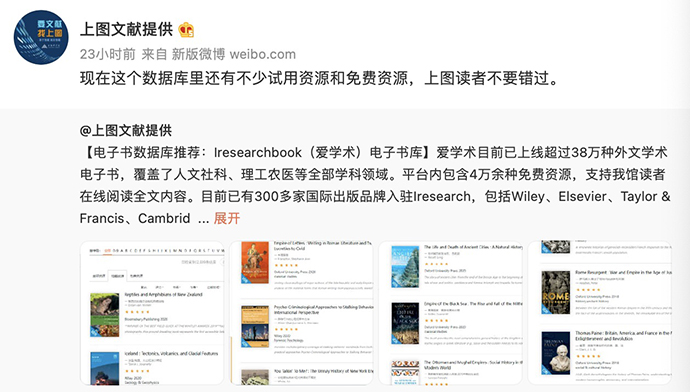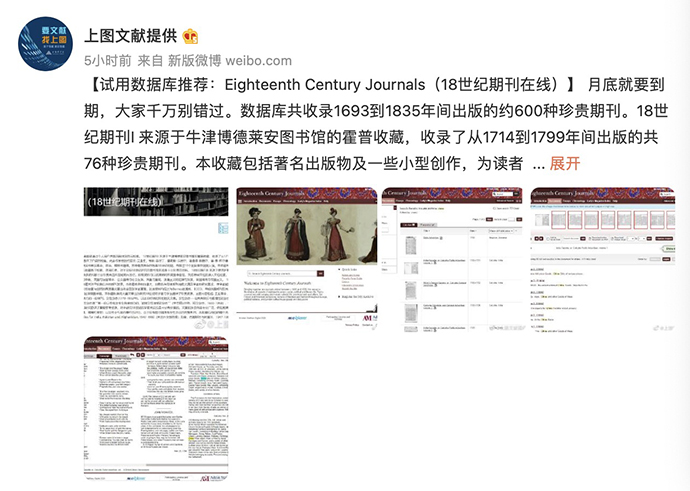
On June 23, a reporter from The Paper learned from Shanghai Library that from March to May, the number of visits to the professional service portal (z.library.sh.cn) in the picture above reached 6.7 million, an increase from the same period last year. 3.31 million times, an increase of 103%. In other words, in the nearly three months that the library above was closed due to the epidemic, the number of online readers has doubled!  Since the temporary closure on March 10, the above map has actively carried out various online activities such as "Shangtu Cloud Lecture" and "Cloud Talk Shanghai", and has continuously opened up more remote use of academic resources. According to the latest business data, during this period of closure, an average of 70,000+ readers per day browsed the vast digital resources in the above picture online.
Since the temporary closure on March 10, the above map has actively carried out various online activities such as "Shangtu Cloud Lecture" and "Cloud Talk Shanghai", and has continuously opened up more remote use of academic resources. According to the latest business data, during this period of closure, an average of 70,000+ readers per day browsed the vast digital resources in the above picture online.
"We are a little surprised ourselves, but we can expect that the professional service portal in the picture above will be welcomed by readers." Chen Zhe, director of the professional service center in the picture above, told The Paper that the professional service portal in the picture above was launched at the end of 2019, and soon after that In the face of the epidemic in 2020, "it immediately played a role, replacing 'going to the museum' and becoming a favorite online service channel for readers."
Because of the experience in 2020, the professional service portal pictured above is more calm when dealing with temporary closures this year. In the past, due to copyright restrictions, the use of a considerable part of the database resources in the above picture required readers to be in the library. This year, the editorial center for the above picture immediately contacted major database suppliers to discuss granting remote access to the database, so that the readers of the above picture can stay at home. These rich resources can also be used at home.
"As long as you have the reader card in the picture above, you can use these databases for free." Chen Zhe said that during the epidemic, they opened the remote access to heavyweight databases, increased the remote access to the main site for common databases, and added professional access to foreign language databases. In general, the number and methods of remote database use have been improved, and the convenience has also been increased. A total of 30 trial databases have been added, many of which are very popular. The Weibo "Above Documents" of the professional service portal above also recommends various databases online from time to time, such as the trial database "Eighteenth Century Journals" (18th Century Journals Online), which contains about 600 precious journals published between 1693 and 1835. ); the trial database "The Harper's Bazaar Archive", which contains all the contents of Bazaar magazine since its inception in 1867; has launched more than 380,000 academic e-books in foreign languages, covering humanities, social sciences, science, engineering, agriculture and medicine The e-book database "Iresearchbook" (Love Academic) in all disciplines and other fields; the archive database "Qing Dynasty Archives and Documents Database" containing the digitized content of the key Qing historical archives of China's First Historical Archives... From March to May, Weibo 262 pieces of information were released on "Documents Provided in the Picture Above", with a total of 2.176 million readings and 3,505 interactions. Most of the forwarding, comments and likes revolved around professional academic resources.
The Weibo "Above Documents" of the professional service portal above also recommends various databases online from time to time, such as the trial database "Eighteenth Century Journals" (18th Century Journals Online), which contains about 600 precious journals published between 1693 and 1835. ); the trial database "The Harper's Bazaar Archive", which contains all the contents of Bazaar magazine since its inception in 1867; has launched more than 380,000 academic e-books in foreign languages, covering humanities, social sciences, science, engineering, agriculture and medicine The e-book database "Iresearchbook" (Love Academic) in all disciplines and other fields; the archive database "Qing Dynasty Archives and Documents Database" containing the digitized content of the key Qing historical archives of China's First Historical Archives... From March to May, Weibo 262 pieces of information were released on "Documents Provided in the Picture Above", with a total of 2.176 million readings and 3,505 interactions. Most of the forwarding, comments and likes revolved around professional academic resources. 
 According to statistics, in terms of usage alone, the most used databases by readers in the above picture are Chinese comprehensive databases, such as Duxiu, Wanfang, VIP and CNKI. However, readers in the above picture will not only search one database, but often start with a common comprehensive database, with subdivided subject-specific professional databases. Usually a reader will commonly use four or five databases. Professional databases have always had user fans in their respective fields: ProQuest’s WWD is liked by users in the fashion and fan circles, the Shenbao database has always been favored as a modern Shanghai research tool, and the IEEE database has always had readers to apply for remote applications. Interviews, ProQuest dissertations are also quite popular, and every recommendation from China Social Science Library is responded like a wave.
According to statistics, in terms of usage alone, the most used databases by readers in the above picture are Chinese comprehensive databases, such as Duxiu, Wanfang, VIP and CNKI. However, readers in the above picture will not only search one database, but often start with a common comprehensive database, with subdivided subject-specific professional databases. Usually a reader will commonly use four or five databases. Professional databases have always had user fans in their respective fields: ProQuest’s WWD is liked by users in the fashion and fan circles, the Shenbao database has always been favored as a modern Shanghai research tool, and the IEEE database has always had readers to apply for remote applications. Interviews, ProQuest dissertations are also quite popular, and every recommendation from China Social Science Library is responded like a wave.
"As librarians, we are also very proud, because our number of visits in a month in 2019 is about 70,000+, and now this is our number of visits in one day. We have completed an order of magnitude leap in three years. Chen Zhe said, "The library itself must adapt to the arrival of the digital age. The above picture has extremely rich digital resources, and its digital dividend should be ahead."
An interesting discovery is that even in the most critical stage of the epidemic, the portal data still maintains that "the number of visits on working days is significantly higher than that on weekends and statutory holidays". "That is, the number of visits from Monday to Friday is still higher than that on weekends and holidays, and everyone still maintains the original rhythm of life." Chen Zhe said with a smile.
 Since the temporary closure on March 10, the above map has actively carried out various online activities such as "Shangtu Cloud Lecture" and "Cloud Talk Shanghai", and has continuously opened up more remote use of academic resources. According to the latest business data, during this period of closure, an average of 70,000+ readers per day browsed the vast digital resources in the above picture online.
Since the temporary closure on March 10, the above map has actively carried out various online activities such as "Shangtu Cloud Lecture" and "Cloud Talk Shanghai", and has continuously opened up more remote use of academic resources. According to the latest business data, during this period of closure, an average of 70,000+ readers per day browsed the vast digital resources in the above picture online."We are a little surprised ourselves, but we can expect that the professional service portal in the picture above will be welcomed by readers." Chen Zhe, director of the professional service center in the picture above, told The Paper that the professional service portal in the picture above was launched at the end of 2019, and soon after that In the face of the epidemic in 2020, "it immediately played a role, replacing 'going to the museum' and becoming a favorite online service channel for readers."
Because of the experience in 2020, the professional service portal pictured above is more calm when dealing with temporary closures this year. In the past, due to copyright restrictions, the use of a considerable part of the database resources in the above picture required readers to be in the library. This year, the editorial center for the above picture immediately contacted major database suppliers to discuss granting remote access to the database, so that the readers of the above picture can stay at home. These rich resources can also be used at home.
"As long as you have the reader card in the picture above, you can use these databases for free." Chen Zhe said that during the epidemic, they opened the remote access to heavyweight databases, increased the remote access to the main site for common databases, and added professional access to foreign language databases. In general, the number and methods of remote database use have been improved, and the convenience has also been increased. A total of 30 trial databases have been added, many of which are very popular.
 The Weibo "Above Documents" of the professional service portal above also recommends various databases online from time to time, such as the trial database "Eighteenth Century Journals" (18th Century Journals Online), which contains about 600 precious journals published between 1693 and 1835. ); the trial database "The Harper's Bazaar Archive", which contains all the contents of Bazaar magazine since its inception in 1867; has launched more than 380,000 academic e-books in foreign languages, covering humanities, social sciences, science, engineering, agriculture and medicine The e-book database "Iresearchbook" (Love Academic) in all disciplines and other fields; the archive database "Qing Dynasty Archives and Documents Database" containing the digitized content of the key Qing historical archives of China's First Historical Archives... From March to May, Weibo 262 pieces of information were released on "Documents Provided in the Picture Above", with a total of 2.176 million readings and 3,505 interactions. Most of the forwarding, comments and likes revolved around professional academic resources.
The Weibo "Above Documents" of the professional service portal above also recommends various databases online from time to time, such as the trial database "Eighteenth Century Journals" (18th Century Journals Online), which contains about 600 precious journals published between 1693 and 1835. ); the trial database "The Harper's Bazaar Archive", which contains all the contents of Bazaar magazine since its inception in 1867; has launched more than 380,000 academic e-books in foreign languages, covering humanities, social sciences, science, engineering, agriculture and medicine The e-book database "Iresearchbook" (Love Academic) in all disciplines and other fields; the archive database "Qing Dynasty Archives and Documents Database" containing the digitized content of the key Qing historical archives of China's First Historical Archives... From March to May, Weibo 262 pieces of information were released on "Documents Provided in the Picture Above", with a total of 2.176 million readings and 3,505 interactions. Most of the forwarding, comments and likes revolved around professional academic resources. 
 According to statistics, in terms of usage alone, the most used databases by readers in the above picture are Chinese comprehensive databases, such as Duxiu, Wanfang, VIP and CNKI. However, readers in the above picture will not only search one database, but often start with a common comprehensive database, with subdivided subject-specific professional databases. Usually a reader will commonly use four or five databases. Professional databases have always had user fans in their respective fields: ProQuest’s WWD is liked by users in the fashion and fan circles, the Shenbao database has always been favored as a modern Shanghai research tool, and the IEEE database has always had readers to apply for remote applications. Interviews, ProQuest dissertations are also quite popular, and every recommendation from China Social Science Library is responded like a wave.
According to statistics, in terms of usage alone, the most used databases by readers in the above picture are Chinese comprehensive databases, such as Duxiu, Wanfang, VIP and CNKI. However, readers in the above picture will not only search one database, but often start with a common comprehensive database, with subdivided subject-specific professional databases. Usually a reader will commonly use four or five databases. Professional databases have always had user fans in their respective fields: ProQuest’s WWD is liked by users in the fashion and fan circles, the Shenbao database has always been favored as a modern Shanghai research tool, and the IEEE database has always had readers to apply for remote applications. Interviews, ProQuest dissertations are also quite popular, and every recommendation from China Social Science Library is responded like a wave."As librarians, we are also very proud, because our number of visits in a month in 2019 is about 70,000+, and now this is our number of visits in one day. We have completed an order of magnitude leap in three years. Chen Zhe said, "The library itself must adapt to the arrival of the digital age. The above picture has extremely rich digital resources, and its digital dividend should be ahead."
An interesting discovery is that even in the most critical stage of the epidemic, the portal data still maintains that "the number of visits on working days is significantly higher than that on weekends and statutory holidays". "That is, the number of visits from Monday to Friday is still higher than that on weekends and holidays, and everyone still maintains the original rhythm of life." Chen Zhe said with a smile.

Readers during the epidemic consult the keyword map. Image source: Shanghai Library's official account of "Looking for the above picture for documents"
Soon, the East Hall of the picture above is also planned to open, and the picture above is constantly creating new reading scenes, reading experiences and reading energy. Chen Chao, the curator of the picture above, said: "Today, with the development of big data, all media, and informatization, we have entered the 'big reading era', and all human five senses are open to reading. In the transition from paper reading to digital reading In the process, the content of human reading has been greatly expanded, buildings can be read, cities can be read, and the reading revolution in a broad sense has also prompted the library to make a transformation. Reading in the 'big reading era' requires the people in the picture above to be physically intelligent Spaces and digital spaces offer more diverse services.”Related Posts